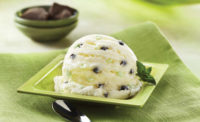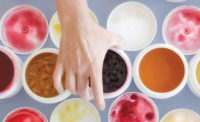Inclusions set a dairy product apart. In an increasingly crowded field, where everything from Greek-style yogurt to ice cream to flavored cheese spreads is fighting for shelf space and share of stomach, even a little edge goes a long way.
While it is common knowledge that “you can take any dairy product, add some inclusions and give it that extra flair that propels it above competitors,” said product developer Kevin W. Holland of Tree Top, Selah, Wash., what is not as obvious is which inclusions are most compatible with which dairy application — and under which processing and storage conditions.
So we gathered some suppliers of inclusions to give us the lowdown on how to make the most of these little extras across the dairy spectrum — and why doing so is worth the effort in the first place. As Holland noted, “The biggest challenge, after choosing which category of inclusions to use, is sometimes picking the right inclusion itself.”
Dairy Foods: Let’s start with the basics. Give our readers the business case for using inclusions.
Katy Cole, technical service manager, Cargill Cocoa & Chocolate, Lititz, Pa.: Adding inclusions to dairy products provides manufacturers with the ability to innovate based on consumer needs. And whether the manufacturer is looking to create an indulgent or better-for-you option or add interesting texture, there are a variety of inclusions that could be considered in the product development phase.
Dairy Foods: Share some examples of applications where inclusions have made a difference.
Holland: The growth and range of products in the YoCrunch line [of yogurts] alone really speaks to the public’s love of inclusions. This desire also comes from the consumer’s desire to customize their food.
Ron Heddleson, senior director of research & development, QualiTech, Inc., Chaska, Minn.: People crave and expect inclusions in their ice cream, and often mix healthy grain inclusions into yogurt.
Dairy Foods: Run though some advantages that inclusions provide behind the scenes, perhaps as a functional formulation ingredient.
Heddleson: We’ve seen that inclusions can provide a point of color, flavor and texture, and may be used to carry functional ingredients like fiber, protein, omega-3s, vegetable or fruit content and nutraceuticals. Inclusions can even solve processing issues, such as fortification with calcium without impacting texture or making beverages or yogurts “chalky,” for example.
Dairy Foods: That dovetails nicely with the health-and-wellness trend reigning over all categories, not just dairy. How has health and wellness influenced contemporary inclusions, and how can we use inclusions to enhance a product’s H&W cred?
Cole: Although there will always be a market for highly indulgent products, there may be a greater push from consumers for more balanced functional dairy products. Adding ingredients, like inclusions, to bolster health claims to create functional foods is a growing trend. Functional foods are important to consumers because they want to indulge while doing something good for their health.
Heddleson: Dairy products contain essential nutrients, including protein, essential minerals and vitamins, carbohydrates and essential fats. The ability to enhance any of these, or provide additional nutrients, via the inclusion delivery system is a cost-effective, creative way to address the health-and-wellness.
Dairy Foods: How does a dairy processor “do” inclusions right? What are the main difficulties involved in working with inclusions, starting with the effect of temperature?
John Pimpo, sales manager – East, ingredients & contract manufacturing division, Gertrude Hawk Ingredients, Dunmore, Pa.: From our perspective, manufacturing and storage temperatures are paramount to having a successful inclusion. Storing low-melt inclusions frozen and keeping them as frozen as possible during the manufacturing process seems to be one of the biggest challenges we see with manufacturers. For ice cream, for example, you can actually wind up with some mix-in or topper applications that have a higher temperature from processes or friction, so knowing that will greatly affect what type of inclusion will be best.
Dairy Foods: Any operational best practices you’d suggest?
Pimpo: Keep your inclusions frozen. Only bring onto the floor what you can reasonably use during a run so as not to harm the integrity of the inclusions.
Dairy Foods: This issue of optimizing temperature conditions seems particularly important when working with chocolate inclusions.
Cole: Actually, standard-of-identity chocolate is not typically found in hard-packed or soft-serve ice cream because when chocolate is cooled to these temperatures, it becomes extremely hard to bite. That’s why ice-cream compound inclusions (chunks, chips, flakes) are formulated with low-melt-point oils, such as coconut and soybean blends. These oils have much lower melting points than cocoa butter, easing the bite for the consumer. When a frozen compound inclusion is eaten, it provides a better consumer experience because the inclusion’s melting point is lower than body temperature. This causes the inclusion to melt more readily in the consumer’s mouth.
Dairy Foods: What challenges emerge when you move out of the freezer, as with a refrigerated yogurt, for example?
Pimpo: Inclusions for dairy yogurt are similar to those for ice cream in that porous inclusions will lose their integrity over time if placed directly into the yogurt, hence the need for a sidecar or dome. Chocolate also tends to react adversely when placed directly into the dairy yogurt, so sidecars or dome toppers are best. Manufacturers actually have a little more flexibility when working with frozen products than they do for shelf-stable inclusions that go into refrigerated products.
Cole: Since the chocolate particulates aren’t combined with the yogurt prior to consumption, the chocolate won’t dissolve into the yogurt and the time for unwanted flavor development will be minimal.
Dairy Foods: I’m curious about this issue of textural deterioration of inclusions. Where else does it rear its head, and how can a processor avert it?
Heddleson: The primary challenge is preventing moisture migration and keeping textures as expected — crunchy, for example — throughout longer shelf lives in high-moisture conditions. The inclusions that perform well often have higher fat or protein content and lower moisture content, such that the water present does not freeze and create icy textures. Moisture can be controlled through the use of texturants like starches and gums, too.
Dairy Foods: Are certain inclusions so delicate that they’re not suitable for use in some products or under some processing conditions?
Heddleson: Fruit typically will not be able to withstand high-shear or –pressure processes without losing piece integrity and texture. Shear can also cause fruit to “bleed” color into products and change their hue.
Holland: Higher shear rates may lead us to choose a different variety or even look at adding the fruit at a different point in the processing. The harsher the processing, the more color degradation we typically see. We can build back some color into the fruit inclusion to compensate for this loss.
Dairy Foods: That being the case, how can you make fruit more practical for use as an inclusion?
Holland: It’s important to match the inclusion to the application to avoid any negative outcomes and achieve the desired shelf life.
Dairy Foods: Well, what fruit ingredients let us do that?
Heddleson: Alginate-based fruit inclusions designed for use in ice cream and dairy products form thermo-irreversible gels that can often withstand high shear and pressure while delivering the color and flavor identify of fruit bits, as well as fruit solids content.
Tom Payne, industry specialist, U.S. Highbush Blueberry Council, Folsom, Calif.: The theme today is “give us natural.” Using real fruit presents a natural benefit to dairy formulators. Many blueberry formats work well under frozen conditions, and frozen blueberries especially provide the freshness of blueberries with the convenience of year-round availability.
IQF [individually quick frozen] blueberries are free-flowing, providing individual fruit piece identity, and IQF blueberries don’t need thawing prior to use and can be quickly incorporated into mixes or used as toppings. Puree is wonderful in ice creams and sorbet.
Free-flowing dried blueberries are easy to integrate into products where fruit size and individual piece identity are needed. Blueberry powders can be used as coatings on ice cream or yogurt bars. Freeze-dried products provide crisp flavor notes, tang and real fruit-flavor bursts. And osmotically preserved blueberry products provide fruit size typical of a fresh, whole berry while needing no refrigerated storage.
Dairy Foods: What other advice can you share for formulating with fruit-based inclusions?
Pimpo: Monitor fruit feeder dispersion/weights so as not to crush inclusions before they make it to the final destination. Proper monitoring is time-consuming, but in the long run it’ll make for a better product.
Dairy Foods: So far, we’ve talked about temperature issues, texture and shear. What affect can pH have on inclusion quality?
Heddleson: Acidic pH values can often impact the intensity and vibrancy of natural colors over shelf life. Bright natural reds may become purplish or gray upon extended time in low-pH environments. Thus, the inclusions that fare best under acidic conditions will be ones that create environments of low moisture migration and water activity.
Cole: Working with cocoa powder in fermented dairy products, such as yogurt and cheese, can be challenging as a result of the acidity caused by lactic acid bacteria. Cocoa powder can add buffering capacity, which means that the cultures have to produce more acid to reach pH 4.6. This gives a higher titratable acidity and a tart flavor.
When cocoa powder is used with fermented dairy products, a higher-alkalized cocoa powder that’s dark and strong in flavor is the best option. When formulating with a higher-alkalized powder, a lower percentage of powder can be used in the formulation without impacting flavor. This helps alleviate some of the off flavors generated in chocolate-flavored fermented dairy products.
Dairy Foods: What processing, formulation or product-spec parameters should dairy processors disclose when talking with you?
Holland: It helps to know the product’s moisture level, Brix, pH and processing conditions. Those are the attributes that’ll have the greatest effect on the interaction between the inclusion and the matrix. If you want an inclusion that’ll stay crunchy in a milkshake for four minutes at 34F, then this is important information to have when you talk to your supplier. The more you can share about the application and processing, the higher the probability that you’ll get the right inclusion the first time.
Heddleson: Key specifications to share would include the targeted shelf life, the pH and water activity of the environment, targeted color shades and reference flavor profiles and sizes. It’s also helpful to understand the process conditions that the inclusion has to withstand: pasteurization, shear from pumping, et cetera.
Dairy Foods: Now let’s look at flavor profiles and taste trends. One question that always comes to mind is whether an inclusion should complement its base or contrast it. What’s your verdict?
Pimpo: This’ll come down to consumer preference. You can go both ways: inclusions can complement a product — peanut-butter ice cream with peanut butter cups — or provide a contrasting flavor profile, like what you get when you pair a strong coffee background with a sweet-salty toffee.
Sometimes you have an exceptional flavor profile that doesn’t need an inclusion partner. But if you look at the sea salt/caramel trend that’s big right now, nearly every customer who’s launched this concept with our inclusions has seen success. I’ve had customers actually launch a salty-caramel concept without our caramel sea salt truffles and then come back after the initial launch to say that customers requested it with the truffles.
Dairy Foods: In what off-the-beaten-path flavor directions do you see inclusions heading?
Pimpo: We’re still excited to see how far the sweet-salty trend can continue with our milk-caramel sea salt truffles and dark-caramel sea salt truffles. Of course, a close cousin to this profile — and an old standby — has been chocolate-coated pretzels.
Heddleson: Some of the next big flavors we’re seeing are more on the savory side, like maple bacon, pumpkin, sweet potato, green tea and ash with its smoky notes. On the sweet side, caramel, key lime, coconut and chocolate with chili peppers are consistently popular. We’re also seeing requests for more seasonal flavors like ginger, candy corn, piña colada, eggnog, strawberry shortcake and pumpkin spice.





